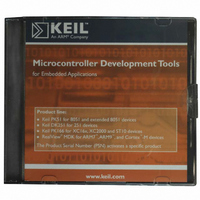MDK-ARM Keil, MDK-ARM Datasheet - Page 13

MDK-ARM
Manufacturer Part Number
MDK-ARM
Description
KIT REALVIEW MCU DEVELOPMENT
Manufacturer
Keil
Type
Compiler and IDEr
Specifications of MDK-ARM
For Use With/related Products
ARM MCUs
Lead Free Status / RoHS Status
Lead free / RoHS Compliant
- Current page: 13 of 156
- Download datasheet (3Mb)
Getting Started: Building Applications with RL-ARM
13
Typically, the host will be a PC. This means that you need to have a deep
knowledge of the Windows operating system and its device drivers. Getting all
of these elements working together would be a development project in its own.
Like the TCP/IP library, the RL-USB driver is a common software stack
designed to work across all supported microcontrollers. Although you can use
the RL-USB driver to communicate with a custom Windows device driver, it has
been designed to support common USB classes. Each USB class has its own
native driver within the Windows operating system. This means that you do not
need to develop or maintain your own driver.
The class support provided with RL-USB includes Human Interface Device
(HID), Mass Storage Class (MSC), Communication Device Class (CDC), and
Audio Class. The HID Class allows you to exchange custom control and
configuration data with your device. The Mass Storage Class allows the
Windows operating system to access the data stored within the RL-Flash file
system in the same manner as a USB pen drive. The Communication Device
Class can be used to realize a virtual COM Port. Finally, the Audio Class allows
you to exchange streaming audio data between the device and a PC. Together
these four classes provide versatile support for most USB design requirements.
CAN
The RL-CAN driver is the one
component of the RL-ARM
library that is tightly coupled to
the RTX. The CAN driver
consists of just six functions that
allow you to initialize a given
CAN peripheral, define, transmit
and receive CAN message
objects, and exchange data with other nodes on the CAN network.
The RL-CAN driver has a consistent programming API for all supported CAN
peripherals, allowing easy migration of code or integration of several different
microcontrollers into the one project. The CAN driver also uses RTX message
queues to buffer, transmit and receive messages, ensuring ordered handling of the
CAN network data.
Related parts for MDK-ARM
Image
Part Number
Description
Manufacturer
Datasheet
Request
R

Part Number:
Description:
KIT REALVIEW MCU DEVELOPMENT
Manufacturer:
Keil
Datasheet:

Part Number:
Description:
Development Software SUPPORT EXTENSION FOR MDK-ARM-B
Manufacturer:
Keil Software

Part Number:
Description:
Development Software SUPPORT EXTENSION FOR MDK-ARM
Manufacturer:
Keil Software

Part Number:
Description:
KIT REALVIEW MCU DEVELOPMENT
Manufacturer:
Keil
Datasheet:

Part Number:
Description:
Development Software MCU DEV KIT FOR ARM UPG TO FLOATING LIC
Manufacturer:
Keil Tools

Part Number:
Description:
Development Software MCU DEV KIT FOR ARM W/ FLOATING LICENSE
Manufacturer:
Keil Software

Part Number:
Description:
Development Software MCU DEV KIT FOR ARM uVISION & C++ & RTX
Manufacturer:
Keil Tools

Part Number:
Description:
Development Software SUPP LICENSE RENEWAL 90+ DAYS NO TECH SUP
Manufacturer:
Keil Software
Part Number:
Description:
KEIL C-COMPILER INTERNATIONAL
Manufacturer:
Silicon Laboratories Inc

Part Number:
Description:
BOARD EVAL FOR LPC213X ARM MCU
Manufacturer:
NXP Semiconductors
Datasheet:
Part Number:
Description:
K60N512 Keil Tower Kit
Manufacturer:
Freescale Semiconductor
Datasheet:










